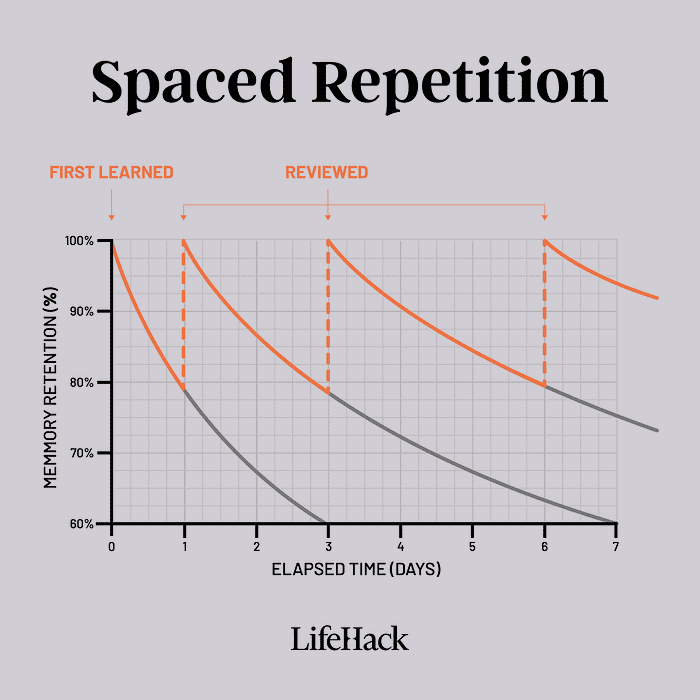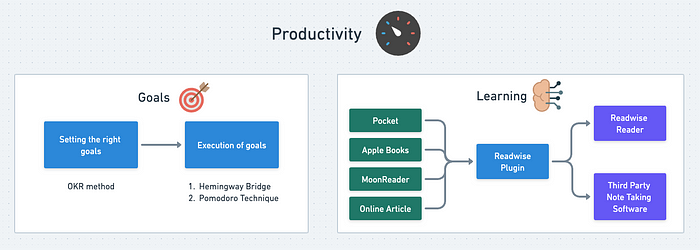Overview
High productivity, or high efficiency as it is defined, means accomplishing more within a fixed period of time. Personally, I am a strong advocate of productivity, which has been ingrained in me from a young age. I believe that being more efficient is the key to staying ahead in life.
While the primary motivation behind striving for greater productivity is to accomplish more and achieve success, there is another aspect of my personality that thoroughly enjoys exploring different methods to streamline my life and eliminate unnecessary time-wasting activities.

Today, I would like to share with you a few of my personal productivity tips that have helped me achieve more. The following is a brief outline of what you can expect in this article:
- Goal Settings: How do I establish goals and effectively monitor my progress?
- Time Management: How do I efficiently manage my tasks and allocate time to ensure that I prioritize the most important ones?
- Note Taking & Learning: How do I effectively learn and organize the knowledge I acquire?
- Recommended Resources & Materials: I will suggest some books, resources, and videos that I believe can further enhance your understanding of various productivity concepts.
By incorporating these strategies into your daily routine, you can make significant strides in improving your productivity and accomplishing more in your personal and professional endeavours.
Goal Settings
First and foremost, the ultimate purpose of productivity is to accelerate the achievement of personal goals. It is crucial to have a clear and concrete goal in mind, as there is no value in being faster if you are moving in the wrong direction.
Personally, I have found the OKR (Objectives and Key Results) method to be highly effective in setting goals and tracking progress. My introduction to this approach occurred during my involvement in the annual planning process at Ant Group, where I was captivated by its efficacy.

When establishing my goals, I typically adopt a timeline of 3–5 years. This duration allows for significant milestones to be reached, while avoiding excessive uncertainty that may arise with longer timeframes, leading to goal adjustments.
Here’s what I will do when I am setting up my goals:
- To set my goals effectively, I embark on a period of introspection, delving into profound questions such as: What do I aspire to achieve in the next 5 years? What kind of life do I envision for myself?
- Once I have a specific goal in mind, I proceed to develop my yearly plan, breaking it down into Objectives, Key Actions, and Results. The Objective represents the desired outcome, the Key Actions states the necessary steps to reach that destination, and the Results serve as benchmarks to measure my progress.
- Next, I create a monthly timeline for my Key Actions, ensuring their timely completion. I engage in weekly planning, emphasizing specificity in tasks to maintain focus and minimize distractions.
- On a bi-weekly basis, I review my progress, recapitulating my accomplishments and engaging in reflection. During this process, I identify both positive aspects and areas for improvement in terms of my execution strategy.
The cycle of Execute, Measure, and Adjust becomes a weekly routine, allowing for continuous improvement and adaptation as needed. This iterative approach serves as a cornerstone of my productivity journey.
Time Management
In the preceding section, we discussed the importance of establishing appropriate goals and maintaining regular progress tracking. This segment on time management delves deeper into the realm of effective execution and offers insights on overcoming inertia and cultivating motivation. Personally, I have found two techniques to be particularly impactful:
Two useful techniques that are very effective for me.
- Pomodoro Technique
- Hemingway Bridge

Pomodoro Technique is likely familiar to many of you. This concept revolves around structuring your work into 25-minute sessions, followed by 5-minute breaks. The main idea behind this technique is to break down larger tasks into smaller, more manageable chunks, thereby promoting a sense of progress. Personally, I have found this approach incredibly beneficial. Whenever I feel the temptation to procrastinate, I remind myself that I only need to focus for 25 minutes before enjoying a short break. This mindset shift has helped me overcome psychological barriers and initiate work on various projects.

Hemingway Bridge which I discovered through the book “Build a Second Brain,” focuses on listing the tasks for the next work session. Many individuals struggle to begin their work, but once they enter a state of flow, they become more inclined to accomplish tasks. By jotting down the upcoming tasks during the current session, you leverage your existing momentum to facilitate a smoother start in the next session. This technique harnesses the power of continuity and reduces the inertia often associated with initiating work.
Implementing these techniques has greatly improved my productivity and motivation levels. They have become valuable tools in my workflow, enabling me to overcome initial resistance and maintain a consistent and effective work rhythm.
Note Taking & Learning
As an avid reader with a diverse range of interests, I often find myself struggling to retain the knowledge I acquire and effectively apply it in my daily life. Thankfully, I stumbled upon a remarkable tool called Readwise, which has become an invaluable asset in organizing my notes and highlights. Allow me to highlight some key features offered by Readwise:
- Syncing Notes from Multiple Reading Tools: Readwise seamlessly integrates with various reading platforms like Pocket and Apple Books. This integration ensures that any notes or highlights you make in your reading apps are automatically synced to Readwise, consolidating them in one central location.
- Export Notes to Note-Taking Software: Additionally, Readwise allows you to export your notes to popular note-taking platforms for further analysis and organization. Many users opt to send their notes to platforms like Notion or Obsidian, where they can delve deeper into the content, conduct thorough analysis, and process the information in a more structured manner.
- Review and Revisit Notes: Readwise not only simplifies the process of reviewing your notes but also offers a game-changing feature. It leverages the concept of spaced repetition, presenting your notes in a flashcard-like manner. This technique aids in better retaining the knowledge over time and reinforces your memory on specific topics. Personally, I dedicate time each day to revise around 12 notes, relishing the mental sparks that arise from rediscovering past ideas. It’s truly a transformative experience when I can connect those ideas with my current situation, often leading to inspiration and significant life changes.

Resources/Materials that I personally recommend
Books
- How to Take Smart Notes: This book introduced me to a transformative idea that enabled me to establish meaningful connections among the notes I take. This concept has revolutionized my approach to note-taking, elevating its impact on my learning and knowledge retention.
- Building a Second Brain: This book offered a practical and accessible guide to note-taking, complementing the principles outlined in “How to Take Smart Notes.” While I found some of the concepts in the first book challenging to implement consistently in my daily life, the templates and guidelines provided in the latter have significantly enhanced my note-taking system.
- Atomic Habits: Although I haven’t delved into James Clear’s “Atomic Habits,” I’ve heard rave reviews about its transformative impact on building lasting change. Clear explores the science behind habit formation and reveals how tiny adjustments can lead to monumental results. Whether you’re looking to enhance your personal life or professional endeavours, this book seems like a valuable resource to create positive, lasting habits.
YouTube Channel
- Ali Abdaal: He shares productivity tips in a manner that’s both enjoyable and informative. His well-crafted videos often become a source of entertainment for me, leaving me captivated even when I’m not specifically seeking productivity advice.
- GingerBread [Chinese]: A voracious reader of self-motivation and productivity books, GingerBread has become my go-to source for discovering new and intriguing ideas
Summary
In this article, I’ve shared my three most impactful productivity areas that have significantly enhanced my life. The diagram below provides a concise overview of how these interconnected elements work together harmoniously.

If you have any personal productivity tips, favourite books, enlightening videos, or valuable resources to share, please don’t hesitate to leave a comment below. I’m eager to learn and discover fresh perspectives from all of you, as collaborative growth is a powerful force.
Thank you sincerely for taking the time to read this piece, and until we meet again, stay inspired and productive!


